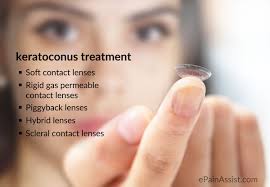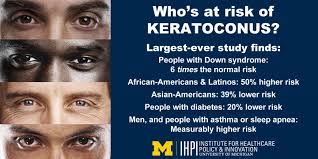KERATOCONUS: SEEING DOUBLE
 As soon as we got home from Wills' Eye Hospital, my mother headed for the bookcase in the living room. She took down the "K" volume of the 1967 World Book Encyclopedia and began to furiously thumb through the volume, muttering to herself, "K..e." She wasn't really sure how to spell the word the ophthalmologist had just told us and we'd been given no literature or handouts. Frustrated, she plopped down the "K" volume and took out the "E". For eye. There she found a cross diagram of an eyeball with the cornea clearly marked, but no explanations of Keratoconus. Finally, she reached for my father's high school Webster's Dictionary. There it was:
As soon as we got home from Wills' Eye Hospital, my mother headed for the bookcase in the living room. She took down the "K" volume of the 1967 World Book Encyclopedia and began to furiously thumb through the volume, muttering to herself, "K..e." She wasn't really sure how to spell the word the ophthalmologist had just told us and we'd been given no literature or handouts. Frustrated, she plopped down the "K" volume and took out the "E". For eye. There she found a cross diagram of an eyeball with the cornea clearly marked, but no explanations of Keratoconus. Finally, she reached for my father's high school Webster's Dictionary. There it was:
Keratoconus: An inflammation of the cornea. Sometimes caused by excessive eye rubbing.
"Okay," she said. "It's just an inflammation. It will go away." She turned and pointed a finger at me. "Stop rubbing your eyes."
When my father came home from work and asked how our visit to Will's had gone, my mother showed him the dictionary. "Ah," he said. "It'll go away."
 But it didn't. And it doesn't. While there are links between Keratoconus and eye-rubbing, and Kertoconus and allergies, and Keratoconus and heredity, the truth is that no one really knows. After the initial diagnosis the year I turned 19, I spent months being fitted for rigid contact lenses. Since my corneas were misshapen, finding a fit that was at least bearable was difficult. Finding ones that were both passably comfortable and provided better vision was almost impossible. And since my corneas continued their propensity to grow into cones and points, the lenses needed to be changed often. I left Millersville State Teachers' College after my freshman year and transferred to West Chester University to be nearer to the eye hospital. And for the next twenty years, through college and marriage and babies, I struggled to wear the contacts.
But it didn't. And it doesn't. While there are links between Keratoconus and eye-rubbing, and Kertoconus and allergies, and Keratoconus and heredity, the truth is that no one really knows. After the initial diagnosis the year I turned 19, I spent months being fitted for rigid contact lenses. Since my corneas were misshapen, finding a fit that was at least bearable was difficult. Finding ones that were both passably comfortable and provided better vision was almost impossible. And since my corneas continued their propensity to grow into cones and points, the lenses needed to be changed often. I left Millersville State Teachers' College after my freshman year and transferred to West Chester University to be nearer to the eye hospital. And for the next twenty years, through college and marriage and babies, I struggled to wear the contacts.
 No one I knew had KC. No one had ever heard of KC. When I squinted or complained about my vision, friends told me to get glasses or stronger lenses. I tried to explain to them about double vision and hazes, about severe eye strain that affected me constantly. The inflammation my parents had thought would just go away did not. By the time I was in my late-thirties, the corneal dystrophy that had affected my right eye in particular had so mutated my cornea that a transplant became my only option.
No one I knew had KC. No one had ever heard of KC. When I squinted or complained about my vision, friends told me to get glasses or stronger lenses. I tried to explain to them about double vision and hazes, about severe eye strain that affected me constantly. The inflammation my parents had thought would just go away did not. By the time I was in my late-thirties, the corneal dystrophy that had affected my right eye in particular had so mutated my cornea that a transplant became my only option.
 While I was pretty much alone in dealing with KC, it is now considered to be the most common ailment of the cornea, affecting about one in every 2,000 Americans. Usually patients have it in both eyes and are otherwise healthy. The disease progresses slowly and may accelerate during pregnancy or from allergies. Like many diseases, the effects of KC are wide-spread. Some people manage quite well with glasses and contacts. Others may need modern procedures such as cross-linking or piggyback lenses to correct the faulty vision. Research done by Tufts et al. (2012) indicates that a cornea transplant is needed about 21% of the time. I am currently awaiting my third.
While I was pretty much alone in dealing with KC, it is now considered to be the most common ailment of the cornea, affecting about one in every 2,000 Americans. Usually patients have it in both eyes and are otherwise healthy. The disease progresses slowly and may accelerate during pregnancy or from allergies. Like many diseases, the effects of KC are wide-spread. Some people manage quite well with glasses and contacts. Others may need modern procedures such as cross-linking or piggyback lenses to correct the faulty vision. Research done by Tufts et al. (2012) indicates that a cornea transplant is needed about 21% of the time. I am currently awaiting my third.
 One of the ongoing problems with KC is that it is often detected too late. A regular optometrist cannot make a definitive diagnosis. By the time the coning of the cornea is detected, it is too advanced for most minimally invasive procedures to be effective. Many who have KC choose to simply "Suffer in silence", finding ways to deal with decreased vision. Those of us who have Keratoconus are quite clever about finding ways to live a relatively normal existence. We often stop driving at night, limit our computer time, and avoid close work.
One of the ongoing problems with KC is that it is often detected too late. A regular optometrist cannot make a definitive diagnosis. By the time the coning of the cornea is detected, it is too advanced for most minimally invasive procedures to be effective. Many who have KC choose to simply "Suffer in silence", finding ways to deal with decreased vision. Those of us who have Keratoconus are quite clever about finding ways to live a relatively normal existence. We often stop driving at night, limit our computer time, and avoid close work.
By the time I was diagnosed at 19, the cornea of my right eye had already "coned." My options right now are limited. While my second transplant lasted almost 20 years, it has now "failed" and a new graft is needed. But despite the erratic vision that punctuates my life, I've found ways to cope with it. I've taught school for more than twenty years, earned both a graduate and post-graduate degree, and currently teach college. I've raised a family of three, cared for a disabled husband, and published three books. And while I now need to use a large monitor on my computer and I've long since given up needlepoint, I've refused to let it limit my life.
 There are on-line groups for those who have KC. We share stories of stopping at a mailbox because we think it's a person, of mistaking a line of trees for a line of people, and of grabbing onto stair railings because steps look like sliding boards. We try to have a good sense of humor about it. Sometimes it's downright funny. I spent five minutes petting my son's cat one day, only to find out it was his jacket. I'd wondered why she was not moving.
There are on-line groups for those who have KC. We share stories of stopping at a mailbox because we think it's a person, of mistaking a line of trees for a line of people, and of grabbing onto stair railings because steps look like sliding boards. We try to have a good sense of humor about it. Sometimes it's downright funny. I spent five minutes petting my son's cat one day, only to find out it was his jacket. I'd wondered why she was not moving.
This is World Keratoconus Awareness Day. The first ever. Research is finally happening for KC and some new treatments are in the beginning stages. One day, perhaps we will fully understand what makes the cornea of some of us so misshaped. In the meantime, let's try to be sensitive to those who are "differently sighted."
And don't think we're crazy if we try to pet your jacket.
No comments:
Post a Comment